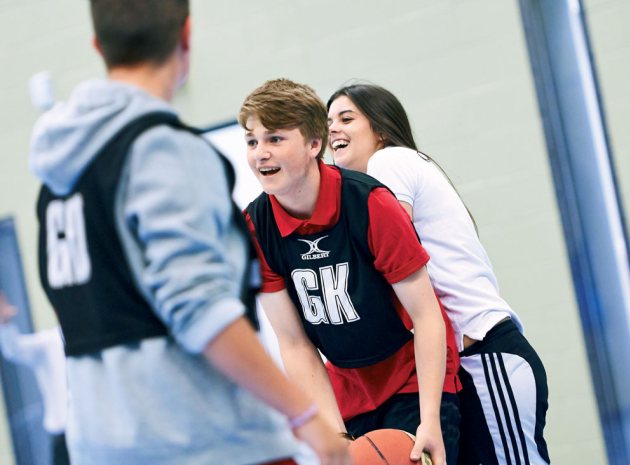When it comes to deciding how sport is best taught in schools, it seems as though everyone has an answer, says Crispin Andrews…
On the subject of sport in schools, it seems that no one is ever happy for long. The Rugby Football Union is slammed for promoting non-competitive rugby for under tens; Marylebone Cricket Club research shows 64% of children and young people don’t care about winning and losing. Ofsted complains that too many schools see sport as an optional extra, a hark back to the bad old days of the eighties and early nineties. School sport charity, the Youth Sport Trust, has started talking about postcode lotteries determining pupils’ sporting provision, again. And an all-party report into the obesity epidemic pretty much tells us that more adults would prefer to drive down the shops to get beer and fags than take an exhilarating morning run in the pouring rain.
Sport is unlike any other subject taught in schools, in that it is a massive phenomenon in its own right, with a unique culture that millions of people buy into, all over the world, backed by a huge multi-billion dollar industry. It’s a world that touches schools and it means that everyone - from the local traffic warden to the barstool Beckenbauers in their pubs - has an opinion on what goes on in PE lessons and in out-of-school-hours sports clubs.
People who haven’t set foot inside a place of education since the day they took their last exam, suddenly become experts on what should and shouldn’t be going on in schools. Particularly when there’s a major event or two on the TV. This summer there was a football World Cup and an Indian cricket tour; in the autumn there’s a Ryder Cup and a Commonwealth Games. Wimbledon, the Premiership, the new Formula 1 season. And if England or English players come up short, like they did in Brazil, it’s not long before fingers start pointing in the direction of teachers and what they do, or don’t do.
This government is pushing competitive sport in secondary schools, although they’ve taken away the school sport coordinators and partnership development managers who used to organise things. Competitive sport is compulsory for primary school children. Primary schools get £8,000 a year, for the next two years, to deliver sport.
Theoretically, the primary school programme should, eventually, and if the money is around for long enough, see more eleven year olds arriving at secondary school with better skills and more interest in sport.
Former Derbyshire cricketer Adrian Rollins, who teaches PE and maths at the Bemrose School in Derby, thinks that infrastructure, not money, will determine whether this actually happens. “Most primary school teachers aren’t sports specialists,” he says. “When a primary school doesn’t have a specialist on its staff, I’d like to see the SLT buy in expertise from a local secondary school, nearby sports clubs or a coaching company.”
Rollins adds that primaries should look to secondaries to provide staff training, as they did during the school sport partnership days. Many of those primary teachers who had training are still in schools today, but Adrian Rollins adds that they need ongoing support to make the most of that early input. “When I got my first contract at Derbyshire, that wasn’t the end of my training,” he says. “I had coaches who constantly monitored what I did, and worked with me to improve my performance. In school you don’t get this sort of support.” Without it, Rollins believes, sport can easily become marginalised.
Youth Sport Trust Chief Executive John Steele believes that teachers must be involved in teaching sport. “This programme should be about managing sustainable development in primary school sport,” he comments. “Yes of course a head teacher could get someone in to deliver their sport for two years, but when the money runs out, they’d be back to square one, with no more capacity to deliver sport than they had before.”
Derek Peaple, head teacher at Park House School in Newbury releases one of his PE teachers for two days to work with feeder primaries. “We run a whole programme of sports clubs and teacher training and primary schools choose what they want to get involved in,” he explains. ‘”t costs them between £2500 and £5000 and they keep the rest of the £8000 to use elsewhere. Primary children get high quality sport now and teaching staff get training so if government does stop the money, their school still has the capacity to deliver sport themselves into the future.”
When the current government talks about sport, it means traditional, competitive sport. Football, rugby, cricket and athletics - not Bollywood dancing and speed-stacking. Not everyone agrees with this focus. The RFU for a start, which argues that skill development and fun should form the basis of a young person’s sporting experience.
Professor Richard Bailey from Liverpool John Moores University says that too much competition, too early can put children off. “There’s not a shred of evidence from anywhere in the world that kids who do only competitive sport, become better elite players,” he says. In Germany and Holland, kids play football for fun and to become better players. Teams over there only worry about winning when the kids are older. In both countries people are happy with the culture, and it works. But in England, opinion is divided.
Adrian Rollins thinks that competitive sport is an essential part of the skill development process. “You can do all the skill development you want but you need to know if you can execute those skills,” he observes.
Rollins adds that it’s the process of competition that provides a beneficial learning experience for young people, rather than the outcome or result. “Whether you win or lose you analyse what you did, how you did it, and try to learn from it so you can do better next time,” he says. Winning, then, is important, because it inspires this process. “It’s not a case of ‘if you win you’ve done well, and if you lose, you’ve failed,’” Rollins adds.
John Steele believes that schools shouldn’t be judged on their competitive school sport provision alone. “It is important for them to also deliver a balanced programme of high quality PE, alongside adequate opportunities to participate in different sports,’ he says. “Without this balance, young people will not be afforded the best chances in sport or in life.”
Derek Peaple thinks competition is good for children, but that in order to benefit from it, they need to be taught good basic skills at primary school. These skills can then be refined, and taken in whatever direction the young person chooses, at secondary. Developmental, child-centred and process - rather than outcome - orientated. It’s good for children, but this sort of talk doesn’t hold much sway down the pub. Not when England has a bad World Cup or loses the Ashes.
Unfortunately, there are more blokes down pubs than there are PE teachers and sports coaches. More Daily Mail readers, more voters. And so the row continues.
In pursuit of excellence
The report, ‘Going the extra mile: Excellence in competitive school sport’, commissioned by Ofsted after the London Olympics to explore why so many Team GB athletes had been educated in private rather than state schools, found:
- A disproportionately high number of elite senior sportsmen and women that began their careers from a private schooling background – the majority of English Premiership rugby union players and more than a third in top-level cricket.
- Schools where pupils lack opportunities to excel in sport also tend to do worse academically.
- The majority of state school head teachers said competitive sport was optional. Thirteen percent said they expected all students to take part.
- Strong teams rely on teachers prepared to dedicate time and energy before, during and after school, as well as at weekends.
- Staff should identify talented pupils for extra coaching and ensure matches are accessible to everyone else.
- Ofsted visited 10 independent schools, 35 state schools and surveyed more than 500 head teachers and more than 1,000 11 to 18-year-olds.
- Fifteen of the state schools visited were “delivering excellence” in competitive sport.
About the author
Crispin Andrews is a freelance writer and a former teacher and sports coach. He prefers cats, werewolves and cricket to DIY, staff meetings and reality TV.










When the current government talks about sport, it means traditional, competitive sport.